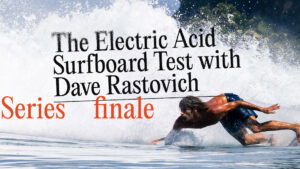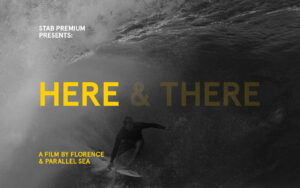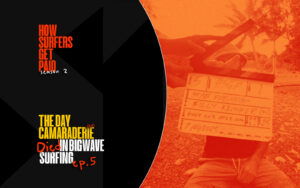Nat Young (OG) Discusses The Shortboard Revolution, How Competitive Surfing Came To Be, And His New Book
Hey kids, here’s a history lesson courtesy of the ’66 World Champ.
“Surfing puts you in the greatest church of all, the open sea and the open sky,” Tom Blake famously said.
Since then, the phrase has been parsed down simply to “the church of the open sky” when referring to the cultish religion that is surfing. It’s been used in a myriad of articles and movies, and it is also the title of Nat Young’s latest tome.
“For the past forty years or so, ever since my meeting with surfing pioneer Tom Blake, who I believe was the first to coin the phrase ‘The Church of the Open Sky’, I have never hesitated to tell anyone who asks that I am a member,” writes Young in the opening chapter of the book.
“Church of the Open Sky” is Young’s seventh book. With a foreword by Pulitzer-winner William Finnegan, it features well-crafted, highly entertaining stories and anecdotes, including can’t-miss tales about traveling through Afghanistan and Nepal in 1972 with enfant terrible Miki Dora, how low rail, “edge boards” came to be, and how one day at San Onofre in 1983 with Tom Blake got him to reconsider how he perceives surfing.
“I have never thought of surfing as a sport – not a traditional sport, anyway,” writes Nat. “It’s not something you do casually, like playing a round of golf with your mates on weekends. It’s much more of a drug, a lifestyle, a religion.”
Stab recently caught up with Nat to talk about the new book and get a proper surf history refresher…
From the title to the opening chapter, the influence of Tom Blake is prominent in your new book, what was your relationship with Tom?
Tom Blake, I only met him once, and we set it up via letters. I was writing letters to him in Wisconsin and he was writing me back. I was trying to figure out when he’d be in California. This was in 1982. We eventually got together at San Onofre and had a good half of a day just talking about the whole state of surfing, how it had got there, and why it was how it was. The reason we met in November in California was because he found the summer heat too much for him at 80 years of age.
“Church of the Open Sky,” those were his words and it was what he was all about. He was of the idea where nature equals god, and his copy of “Voice of the Atom,” he actually gave me that afternoon. In my book, I run one of the letters that he wrote to me about how great it will be when all the religions of the world realize they’re all one, and that really it’s all about nature and god, you know. So he was right on as a surfer, I think, and a great influence on me as a human being. To be able to stand tall and proud in his 80s, to me on a personal level, it gave me a deeper understanding.
Are there any stories about Tom that come to mind?
He told me about how the Duke was all stoked when he beat him in a swim race. That sort of stuff, it takes a great man like the Duke, to accept that he’s been beaten by somebody. And then for Tom to actually be able to do that, for me it was just so interesting. There were so many facets to that conversation that afternoon.
For a guy that is known for the impact he had on competitive surfing, today your stance is that surfing is not a sport?
Correct. I don’t believe the Polynesians surfed as a sport. I think they did it much more as a religion. And that’s evidenced by the blessings of the tree before they cut it down, the ceremonial building of the surfboard, as well as having a separate beach for the aliʻi and the common people.
There are so many things I got into when I really started to do research for this book. Probably one of the most interesting is that in Captain Cook’s logs so many people have overlooked the fact that when he was first watching surfing in Tahiti, he observed that the Polynesians were catching waves and then paddling back out to ride another one. And they’d do it again and again, and he’s going, that means they’re not just riding to come back from fishing, but they’re actually doing it as a form of enjoyment. That was a pretty big thing for me because it tied back in with the writings of Lieutenant King [After Cook’s death, Lieutenant James King was made First Lieutenant of the Discovery and completed the narrative portion of Cook’s journals], who described how they witnessed 20 or 30 people riding surfboards when they got to Hawaii.
Originally, it had nothing to do with a contest. In the early days in Australia when people got together they’d call it a “rally.” And in Hawaii, Buffalo [Keaulana] still calls it a “meet.” It wasn’t a fucking competition. You brought your woman, your dogs, your surfboards, and you all came down to the beach and hung out. And that’s what King describes seeing the first time he encountered surfing in Hawaii.
So when does surfing become a sport?
To me, if it hadn’t been for people at the Outrigger Canoe Club and places like that, it never would have been a competition. They turned surfing into a competition. They were looking to put a label on it like all the other sports. That’s why the first chapter of my book is called, “Surfing is not a sport.” It’s been a misnomer for a long time. I had great stuff to make that case. From Tom Blake, to research at the Bishop Museum, there’s a lot in there.
But if we could transition a little, your board, Magic Sam, and performance at the 1966 World Contest were, in part, responsible for launching the Shortboard Revolution and a new era of hyper-competition in surfing…which kind of gets us to where we are today.
Magic Sam was really influenced by Bob McTavish. He was a major player in that whole shortboard thing, as far as I was concerned in Australia. I was traveling a lot around then and didn’t see any boards that were like that. We’re talking ’66 now, and it took a long time for Hawaii to catch on, I think. And then when they caught on, I always say that the major contribution of the low rail came from Hawaii. I think I cover the development pretty well in my Edge Board chapter.
To get back to the essence of it, I was traveling a lot up the coast to Noosa Heads and Alexander Headlands. From ’65 to ’66 I probably made five trips up there. That’s where Bob was building his boards with Hayden Kenny. Then he went out on his own and was building these boards with a really tight rail. They were still 50/50 rails, but they weren’t eggy. They were much tighter, almost half of the volume on the rail that everyone else was surfing on their boards. That meant that you had a very round bottom and a very round top, and that’s what Sam had. It wasn’t that he was so radically different to what Bob McTavish and Russell Hughes were riding, basically we all got on to it pretty fast.
You could see that the boards had sensitivity. The sensitivity really came with the introduction of Greenough’s Stage 3 fin. That was really what did it for me. That’s what I see as the major reason that I won that contest in San Diego was because George sanded the old fin off the board and put a new one on there. It made a real difference in the performance of the board. It would leap out of turns. It was a fin that actually flexed, and before that, I didn’t have a fin that flexed at all.
Yeah, as I’ve always understood it the secret to Magic Sam was Greenough’s fin?
I had copied the outline of the Greenough fin from my time up the coast, but I really didn’t understand how to sand fins properly. I thought I was going in the right direction, but when George showed me the difference in the type of foils, whether it could be a flat foil or it could be a curved foil, that made a huge difference to the performance of the board.
George was fooling around with McTavish up at Alexander Headlands. He wasn’t working for him, he’d been a commercial fisherman out of Santa Barbara for quite a while at that stage, so when he came to Australia, which I believe was ’64, I think, from memory. He made a real impact on us because we could see that you could store energy in the fin, which was energy in the board, which could drive you forward.
He was living in the same house as Russell Hughes and all the guys that worked at Hayden’s. The same as Bob McTavish. And I’d come up the coast because I was really looking for inspiration, as far as my surfboards were concerned. I wasn’t getting it down in Sydney, so I was traveling every chance I got. I was also old enough to have a driver’s license. I was driving up to Queensland and doing it. It was a really good thing to do, I enjoyed those days immensely because there was hardly anybody surfing, especially on the weekdays, and everyone was a good surfer. We could have a lot of fun together. And George was such a trip to actually hang out with.
I made Magic Sam at Gordon Woods Surfboards in Sydney and took it up the coast and rode it many places. Then I brought it over to California and a guy called Ted Wilson and John Witzig and I were invited up to George’s family home in Montecito. Then we got to surf the Ranch, Rincon, all those places. That was kind of the testing ground to prove that the board was surfing really well. But as I say, it wouldn’t have been surfing well if it hadn’t been for George grabbing the thing and making a new fin for it.
So, when you went into the ’66 World contest, did you know you were going to shake things up?
I knew that I was surfing really different because I wasn’t noseriding. I mean, I was, but our theory about noseriding was that when the curl presented itself you’d either go down and get under the curl or you’d noseride away from it. I could noseride just fine, but I couldn’t do anything about the time on the tip like David Nuuhiwa. I was super impressed by David’s surfing and his ability to ride the nose. For me, it was just the circumstances, I guess. Because my surfing was a bit different, I won on that basis, I suppose.
I didn’t really follow it up until Dewey Weber contacted me. He wanted me to be on his design team. But before that, I’d given the board to Rich Harbour to build copies of and I’ve never seen it since. Apparently, a guy that worked for him said that it got shipped to Hawaii. I have no idea whether that’s true, I just never saw the board again, that’s for sure. I thought he was going to make a model with my name on it, that’s what we’d talked about, and I never saw it again. But you know, c’est la vie.
Would you call that the start of the Shortboard Revolution?
It’s really hard to assess who was doing what because there were such radical changes coming out so quickly. You have to be careful in overlapping these eras and what was really going. The extreme shortboards in Australia, I can say for sure, that was in ’69. I remember surfing a board that was 5’11”— and I was over six feet tall. Somebody like Wayne Lynch was surfing a 5’6” all day, every day. They were our go-to boards. And I think that’s when Pocket Rockets came into Hawaii and they were doing the extreme shortboards.
Reno [Abellira] is a very good example. He actually took one of those boards to the World Championships in ’68 in Puerto Rico. But that was the tip of what was really going on. I don’t really know what was going on in Hawaii only because I wasn’t there all the time. I was going there, but I was so absorbed in what I was doing that I never really concentrated on other stuff or even really put my head up too much. It was a real time. Pardon the pun, but it was a time of real evolution—which is exactly what we were working on with Witzig’s movie.
I still feel really good about the whole era and how it all developed. George played it how he wanted to. And Bob became exactly what Bob is. He’s not a very good businessman, but he’s a hell of a bloody shaper, and a good guy and a good surfer, so he’s kept doing what he’s doing. I still see him quite regularly. It’s great.
I saw George last year. He’s good. He’s out to kill every shark he can because he reckons they’re the enemy. Other than that, he’s the same George, just like a stoked little boy in so many senses. It’s just that he’s got this incredible passion for detail and an ability to finish whatever he starts. Be it building a fin or building a boat, he’s a classic. He discovered the benefits of hard edges on the bottom of his boards about the same time as the Hawaiians did, he called ’em chines, he still uses them on all the boards he designs.
I would say that from a design point of view, George has contributed more than anyone else in the world. And I would also say, that Bob played with the concepts that George was introducing him to. We had to deal with the fact that we weren’t on kneeboards, so our center of gravity wasn’t low. We were standing up. That was the biggest reality for me. I spent weeks working on a board that looked exactly like his at Gordon Woods surfboards. The board’s actually kicking around different museums in Australia now. But it had the full flex tail and everything. The thing is when you stood up on the thing it sunk.
So I had to come to terms with the fact that it was a ridiculous idea that I could surf like George Greenough standing up—not on a kneeboard anyway. The spoons are amazing, but that was the last time I was on one. Actually, that’s not true. I tried to lay down on one time in the ‘60s, but it didn’t work. Unless you knew how to load the gun you couldn’t fire it. You have to be George Greenough to know how to do that.
George is the only genius we’ve ever had in the evolution of surfing. We’ve had a lot of really talented, smart people that have contributed a lot, but for me, George was the genius. There’s so many aspects to what George is thinking. From cameras, to boards, to fish, he’s out there.














Comments
Comments are a Stab Premium feature. Gotta join to talk shop.
Already a member? Sign In
Want to join? Sign Up